Deck 5: The Architecture and Birth of Planetary Systems
سؤال
سؤال
سؤال
سؤال
سؤال
سؤال
سؤال
سؤال
سؤال
سؤال
سؤال
سؤال
سؤال
سؤال
سؤال
سؤال
سؤال
سؤال
سؤال
سؤال
سؤال
سؤال
سؤال
سؤال
سؤال
سؤال
سؤال
سؤال
سؤال
سؤال
سؤال
سؤال
سؤال
سؤال
سؤال
سؤال
سؤال
سؤال
سؤال
سؤال
سؤال
سؤال
سؤال
سؤال
سؤال
سؤال
سؤال
سؤال
سؤال
سؤال
سؤال
سؤال
سؤال
سؤال
سؤال
سؤال
سؤال
سؤال
سؤال
سؤال
سؤال
سؤال
سؤال
سؤال
سؤال
سؤال
سؤال
سؤال
سؤال
سؤال

فتح الحزمة
قم بالتسجيل لفتح البطاقات في هذه المجموعة!
Unlock Deck
Unlock Deck
1/70
العب
ملء الشاشة (f)
Deck 5: The Architecture and Birth of Planetary Systems
1
The density of a terrestrial planet is an imperfect indicator of its location in the Solar System because:
A) it is affected by the planet's rotation.
B) the trend in mass with orbital radius is stronger.
C) it is affected by the planet's self-gravity.
D) it depends on composition.
A) it is affected by the planet's rotation.
B) the trend in mass with orbital radius is stronger.
C) it is affected by the planet's self-gravity.
D) it depends on composition.
it is affected by the planet's self-gravity.
2
A comet is best described as a:
A) ball of gas.
B) ball of ice.
C) dirty snowball.
D) carbonaceous rock.
A) ball of gas.
B) ball of ice.
C) dirty snowball.
D) carbonaceous rock.
dirty snowball.
3
Astronomers discover an icy body in our Solar System with a radius of 10,000 km traveling on a circular orbit.It is most likely to be a(n):
A) Kuiper Belt object.
B) meteor.
C) ice giant planet.
D) asteroid.
A) Kuiper Belt object.
B) meteor.
C) ice giant planet.
D) asteroid.
Kuiper Belt object.
4
A body passing through Earth's atmosphere that creates a streak of light in the sky is a:
A) meteor.
B) meteorite.
C) meteoroid.
D) nova.
A) meteor.
B) meteorite.
C) meteoroid.
D) nova.

فتح الحزمة
افتح القفل للوصول البطاقات البالغ عددها 70 في هذه المجموعة.
فتح الحزمة
k this deck
5
Arrange the following types of planets in order of increasing distance from the Sun:
A) terrestrial planets, ice giants, gas giants.
B) gas giants, terrestrial planets, ice giants.
C) terrestrial planets, gas giants, ice giants.
D) ice giants, gas giants, terrestrial planets.
A) terrestrial planets, ice giants, gas giants.
B) gas giants, terrestrial planets, ice giants.
C) terrestrial planets, gas giants, ice giants.
D) ice giants, gas giants, terrestrial planets.

فتح الحزمة
افتح القفل للوصول البطاقات البالغ عددها 70 في هذه المجموعة.
فتح الحزمة
k this deck
6
Pluto is closest in mass to:
A) Ceres.
B) Mercury.
C) Earth's Moon.
D) Eris.
A) Ceres.
B) Mercury.
C) Earth's Moon.
D) Eris.

فتح الحزمة
افتح القفل للوصول البطاقات البالغ عددها 70 في هذه المجموعة.
فتح الحزمة
k this deck
7
The largest explosions in Earth's history were a result of:
A) radioactivity in Earth's core.
B) Earth-crossing asteroids.
C) nuclear weapons.
D) volcanoes.
A) radioactivity in Earth's core.
B) Earth-crossing asteroids.
C) nuclear weapons.
D) volcanoes.

فتح الحزمة
افتح القفل للوصول البطاقات البالغ عددها 70 في هذه المجموعة.
فتح الحزمة
k this deck
8
Among the terrestrial planets,which of the following properties decreases with distance from the Sun?
A) mass
B) uncompressed density
C) radius
D) rotation rate
A) mass
B) uncompressed density
C) radius
D) rotation rate

فتح الحزمة
افتح القفل للوصول البطاقات البالغ عددها 70 في هذه المجموعة.
فتح الحزمة
k this deck
9
A Solar System body with a dozen moons,a mass of 15 Earth masses,and strong magnetic fields is most likely a(n):
A) dwarf planet.
B) terrestrial planet.
C) gas giant.
D) ice giant.
A) dwarf planet.
B) terrestrial planet.
C) gas giant.
D) ice giant.

فتح الحزمة
افتح القفل للوصول البطاقات البالغ عددها 70 في هذه المجموعة.
فتح الحزمة
k this deck
10
A meteor shower occurs when:
A) an asteroid breaks up near Earth.
B) Earth passes through the asteroid belt.
C) Earth passes through a comet's orbit.
D) a comet breaks up near Earth.
A) an asteroid breaks up near Earth.
B) Earth passes through the asteroid belt.
C) Earth passes through a comet's orbit.
D) a comet breaks up near Earth.

فتح الحزمة
افتح القفل للوصول البطاقات البالغ عددها 70 في هذه المجموعة.
فتح الحزمة
k this deck
11
Most of the dwarf planets in our Solar System reside within the:
A) scattered disk.
B) Kuiper Belt.
C) asteroid belt.
D) moons of the giant planets.
A) scattered disk.
B) Kuiper Belt.
C) asteroid belt.
D) moons of the giant planets.

فتح الحزمة
افتح القفل للوصول البطاقات البالغ عددها 70 في هذه المجموعة.
فتح الحزمة
k this deck
12
A bright,extended object appears in the sky one evening,visible to the naked eye.Over the next several weeks,it moves across the sky,becoming brighter as it approaches the Sun and then fainter again as it moves away.After six weeks,it fades away.This is most likely a(n):
A) supernova.
B) Earth-crossing asteroid.
C) Trojan asteroid.
D) comet.
A) supernova.
B) Earth-crossing asteroid.
C) Trojan asteroid.
D) comet.

فتح الحزمة
افتح القفل للوصول البطاقات البالغ عددها 70 في هذه المجموعة.
فتح الحزمة
k this deck
13
A comet with an orbit near the ecliptic plane and an orbital period of 75 years most likely comes from the:
A) asteroid belt.
B) Kuiper Belt.
C) Oort Cloud.
D) Trojan asteroids.
A) asteroid belt.
B) Kuiper Belt.
C) Oort Cloud.
D) Trojan asteroids.

فتح الحزمة
افتح القفل للوصول البطاقات البالغ عددها 70 في هذه المجموعة.
فتح الحزمة
k this deck
14
The thinker who advocated the existence of worlds around other planets at the end of the sixteenth century was:
A) Tycho Brahe.
B) Johannes Kepler.
C) Nicolaus Copernicus.
D) Giordano Bruno.
A) Tycho Brahe.
B) Johannes Kepler.
C) Nicolaus Copernicus.
D) Giordano Bruno.

فتح الحزمة
افتح القفل للوصول البطاقات البالغ عددها 70 في هذه المجموعة.
فتح الحزمة
k this deck
15
Arrange the following objects in order of increasing distance from the Sun:
A) Earth, asteroid belt, Jupiter, Kuiper Belt, scattered disk, Oort Cloud.
B) Earth, Jupiter, asteroid belt, scattered disk, Kuiper Belt, Oort Cloud.
C) asteroid belt, Earth, Oort Cloud, Jupiter, Kuiper Belt, scattered disk.
D) scattered disk, Earth, asteroid belt, Oort Cloud, Jupiter, Kuiper Belt.
A) Earth, asteroid belt, Jupiter, Kuiper Belt, scattered disk, Oort Cloud.
B) Earth, Jupiter, asteroid belt, scattered disk, Kuiper Belt, Oort Cloud.
C) asteroid belt, Earth, Oort Cloud, Jupiter, Kuiper Belt, scattered disk.
D) scattered disk, Earth, asteroid belt, Oort Cloud, Jupiter, Kuiper Belt.

فتح الحزمة
افتح القفل للوصول البطاقات البالغ عددها 70 في هذه المجموعة.
فتح الحزمة
k this deck
16
An icy,rocky body on a highly elliptical orbit through our Solar System is most likely a:
A) Kuiper Belt object.
B) asteroid.
C) comet.
D) dwarf planet.
A) Kuiper Belt object.
B) asteroid.
C) comet.
D) dwarf planet.

فتح الحزمة
افتح القفل للوصول البطاقات البالغ عددها 70 في هذه المجموعة.
فتح الحزمة
k this deck
17
A Solar System body that has a composition similar to a comet,a strong magnetic field,and a radius about four times larger than Earth must have an average orbital radius closest to:
A) 1 AU.
B) 5 AU.
C) 30 AU.
D) 60 AU.
A) 1 AU.
B) 5 AU.
C) 30 AU.
D) 60 AU.

فتح الحزمة
افتح القفل للوصول البطاقات البالغ عددها 70 في هذه المجموعة.
فتح الحزمة
k this deck
18
The asteroid belt:
A) is the debris field of a destroyed planet.
B) consists of roughly spherical bodies made of silicon and iron.
C) was kept from forming a planet by the gravitational disturbance of Jupiter.
D) contains as much mass as Saturn.
A) is the debris field of a destroyed planet.
B) consists of roughly spherical bodies made of silicon and iron.
C) was kept from forming a planet by the gravitational disturbance of Jupiter.
D) contains as much mass as Saturn.

فتح الحزمة
افتح القفل للوصول البطاقات البالغ عددها 70 في هذه المجموعة.
فتح الحزمة
k this deck
19
Meteoroids can come from:
A) comets.
B) the Moon
C) Mars.
D) all of the above.
A) comets.
B) the Moon
C) Mars.
D) all of the above.

فتح الحزمة
افتح القفل للوصول البطاقات البالغ عددها 70 في هذه المجموعة.
فتح الحزمة
k this deck
20
The first extrasolar planets were discovered in:
A) 1601.
B) 1951.
C) 1995.
D) 2011.
A) 1601.
B) 1951.
C) 1995.
D) 2011.

فتح الحزمة
افتح القفل للوصول البطاقات البالغ عددها 70 في هذه المجموعة.
فتح الحزمة
k this deck
21
The theory that describes the formation of planetary systems is the:
A) condensation theory.
B) core accretion model.
C) disk theory.
D) protoplanetary theory.
A) condensation theory.
B) core accretion model.
C) disk theory.
D) protoplanetary theory.

فتح الحزمة
افتح القفل للوصول البطاقات البالغ عددها 70 في هذه المجموعة.
فتح الحزمة
k this deck
22
The physical principle most directly responsible for the shape of planetary systems is:
A) Newton's second law of motion.
B) the universal law of gravity.
C) conservation of angular momentum.
D) conservation of energy.
A) Newton's second law of motion.
B) the universal law of gravity.
C) conservation of angular momentum.
D) conservation of energy.

فتح الحزمة
افتح القفل للوصول البطاقات البالغ عددها 70 في هذه المجموعة.
فتح الحزمة
k this deck
23
The orbits of the planets in our Solar System:
A) imply that the planets formed elsewhere and were captured by the Sun's gravity.
B) all proceed in the same direction.
C) have a wide range of inclinations.
D) have semimajor axes that follow a regular, repeating pattern.
A) imply that the planets formed elsewhere and were captured by the Sun's gravity.
B) all proceed in the same direction.
C) have a wide range of inclinations.
D) have semimajor axes that follow a regular, repeating pattern.

فتح الحزمة
افتح القفل للوصول البطاقات البالغ عددها 70 في هذه المجموعة.
فتح الحزمة
k this deck
24
Suppose Jupiter's gravity disturbs an asteroid and sends it on an elliptical orbit with a high eccentricity.If the semimajor axis of the resulting orbit is 2 AU,the object would be classified as a(n):
A) Kuiper Belt object.
B) C-type asteroid.
C) Trojan asteroid.
D) Earth-crossing asteroid.
A) Kuiper Belt object.
B) C-type asteroid.
C) Trojan asteroid.
D) Earth-crossing asteroid.

فتح الحزمة
افتح القفل للوصول البطاقات البالغ عددها 70 في هذه المجموعة.
فتح الحزمة
k this deck
25
How do comets from the Oort Cloud differ from comets from the Kuiper Belt?
A) Oort Cloud comets have shorter periods.
B) Oort Cloud comets have smaller masses.
C) Oort Cloud comets have different compositions.
D) Oort Cloud comets have larger inclinations, on average.
A) Oort Cloud comets have shorter periods.
B) Oort Cloud comets have smaller masses.
C) Oort Cloud comets have different compositions.
D) Oort Cloud comets have larger inclinations, on average.

فتح الحزمة
افتح القفل للوصول البطاقات البالغ عددها 70 في هذه المجموعة.
فتح الحزمة
k this deck
26
Compared to our Solar System,the majority of exoplanets have orbits with:
A) higher eccentricity.
B) higher inclinations.
C) smaller semimajor axes.
D) all of the above.
A) higher eccentricity.
B) higher inclinations.
C) smaller semimajor axes.
D) all of the above.

فتح الحزمة
افتح القفل للوصول البطاقات البالغ عددها 70 في هذه المجموعة.
فتح الحزمة
k this deck
27
Hot Jupiters provide evidence for:
A) the greenhouse effect.
B) super-Earths.
C) the condensation theory.
D) planetary migration.
A) the greenhouse effect.
B) super-Earths.
C) the condensation theory.
D) planetary migration.

فتح الحزمة
افتح القفل للوصول البطاقات البالغ عددها 70 في هذه المجموعة.
فتح الحزمة
k this deck
28
Venus is unusual within the Solar System because it:
A) rotates in the opposite sense from its orbit around the Sun.
B) is so massive.
C) has no evidence for active plate tectonics.
D) has a highly inclined orbit.
A) rotates in the opposite sense from its orbit around the Sun.
B) is so massive.
C) has no evidence for active plate tectonics.
D) has a highly inclined orbit.

فتح الحزمة
افتح القفل للوصول البطاقات البالغ عددها 70 في هذه المجموعة.
فتح الحزمة
k this deck
29
The most successful method to date in detecting Earth-sized exoplanets is:
A) the radial velocity method.
B) the transit method.
C) direct imaging.
D) gravitational lensing.
A) the radial velocity method.
B) the transit method.
C) direct imaging.
D) gravitational lensing.

فتح الحزمة
افتح القفل للوصول البطاقات البالغ عددها 70 في هذه المجموعة.
فتح الحزمة
k this deck
30
A planet orbiting a star with a mass one-quarter that of the Sun has an orbital radius of 1/25 AU.If Earth's orbital velocity is 30 km/s,what is the orbital velocity of this planet?
A) 15 km/s
B) 30 km/s
C) 60 km/s
D) 75 km/s
A) 15 km/s
B) 30 km/s
C) 60 km/s
D) 75 km/s

فتح الحزمة
افتح القفل للوصول البطاقات البالغ عددها 70 في هذه المجموعة.
فتح الحزمة
k this deck
31
Arrange the following solar system bodies in order of increasing average orbital inclination:
A) long-period comets, short-period comets, planets, and the asteroid belt.
B) planets, the asteroid belt, short-period comets, and long-period comets.
C) the asteroid belt, planets, long-period comets, and short-period comets.
D) long-period comets, short-period comets, the asteroid belt, and planets.
A) long-period comets, short-period comets, planets, and the asteroid belt.
B) planets, the asteroid belt, short-period comets, and long-period comets.
C) the asteroid belt, planets, long-period comets, and short-period comets.
D) long-period comets, short-period comets, the asteroid belt, and planets.

فتح الحزمة
افتح القفل للوصول البطاقات البالغ عددها 70 في هذه المجموعة.
فتح الحزمة
k this deck
32
The figure below shows two stars.Star A has a mass twice that of our Sun,while Star B has a mass four times that of our Sun.Which labeled point identifies the center of mass of the system? 
A) A
B) B
C) C
D) D

A) A
B) B
C) C
D) D

فتح الحزمة
افتح القفل للوصول البطاقات البالغ عددها 70 في هذه المجموعة.
فتح الحزمة
k this deck
33
The ion tail of a comet points:
A) in the direction of the solar wind.
B) in a trailing orbit near the comet.
C) in the direction of gas jets flowing out of the comet's nucleus.
D) directly behind the comet's position along its orbit.
A) in the direction of the solar wind.
B) in a trailing orbit near the comet.
C) in the direction of gas jets flowing out of the comet's nucleus.
D) directly behind the comet's position along its orbit.

فتح الحزمة
افتح القفل للوصول البطاقات البالغ عددها 70 في هذه المجموعة.
فتح الحزمة
k this deck
34
The radial velocity method is best at detecting exoplanets with ________ orbital radii and ________ masses.
A) small; small
B) small; large
C) large; large
D) large; small
A) small; small
B) small; large
C) large; large
D) large; small

فتح الحزمة
افتح القفل للوصول البطاقات البالغ عددها 70 في هذه المجموعة.
فتح الحزمة
k this deck
35
Astronomers detect a gas giant exoplanet orbiting its host star on an eccentric orbit with a semimajor axis of 100 AU.This provides evidence for:
A) hot Jupiters.
B) eccentric disks.
C) scattering.
D) the snow line.
A) hot Jupiters.
B) eccentric disks.
C) scattering.
D) the snow line.

فتح الحزمة
افتح القفل للوصول البطاقات البالغ عددها 70 في هذه المجموعة.
فتح الحزمة
k this deck
36
The majority of meteoroids are most similar to:
A) the Moon.
B) comets.
C) S-type asteroids.
D) C-type asteroids.
A) the Moon.
B) comets.
C) S-type asteroids.
D) C-type asteroids.

فتح الحزمة
افتح القفل للوصول البطاقات البالغ عددها 70 في هذه المجموعة.
فتح الحزمة
k this deck
37
C-type asteroids differ from S-type asteroids in that C-type asteroids:
A) never underwent differentiation.
B) never have Earth-crossing orbits.
C) are more reflective.
D) are more numerous.
A) never underwent differentiation.
B) never have Earth-crossing orbits.
C) are more reflective.
D) are more numerous.

فتح الحزمة
افتح القفل للوصول البطاقات البالغ عددها 70 في هذه المجموعة.
فتح الحزمة
k this deck
38
The most successful method to date in determining an exoplanet's radius is:
A) the transit method.
B) the radial velocity method.
C) direct imaging.
D) gravitational lensing.
A) the transit method.
B) the radial velocity method.
C) direct imaging.
D) gravitational lensing.

فتح الحزمة
افتح القفل للوصول البطاقات البالغ عددها 70 في هذه المجموعة.
فتح الحزمة
k this deck
39
A planet with a mass of 7-ME is a(n):
A) terrestrial planet.
B) super-Earth.
C) ice giant.
D) gas giant.
A) terrestrial planet.
B) super-Earth.
C) ice giant.
D) gas giant.

فتح الحزمة
افتح القفل للوصول البطاقات البالغ عددها 70 في هذه المجموعة.
فتح الحزمة
k this deck
40
The coma of a comet glows because:
A) of heating produced by radioactive decay in the interior of the comet.
B) atoms become neutral within the coma.
C) of heating and sublimation of the comet's nucleus by sunlight.
D) of refraction by dust grains.
A) of heating produced by radioactive decay in the interior of the comet.
B) atoms become neutral within the coma.
C) of heating and sublimation of the comet's nucleus by sunlight.
D) of refraction by dust grains.

فتح الحزمة
افتح القفل للوصول البطاقات البالغ عددها 70 في هذه المجموعة.
فتح الحزمة
k this deck
41
Most of the asteroids in the asteroid belt are S-type.What does this tell us about their history?

فتح الحزمة
افتح القفل للوصول البطاقات البالغ عددها 70 في هذه المجموعة.
فتح الحزمة
k this deck
42
According to the condensation theory,extrasolar gas giants with orbital radii of about 100 AU formed:
A) about 10 AU from their stars.
B) about 40 AU from their stars.
C) near their present positions.
D) around other stars, and then were captured.
A) about 10 AU from their stars.
B) about 40 AU from their stars.
C) near their present positions.
D) around other stars, and then were captured.

فتح الحزمة
افتح القفل للوصول البطاقات البالغ عددها 70 في هذه المجموعة.
فتح الحزمة
k this deck
43
Two planets,A and B,have identical compositions.Planet A has an orbital radius of 0.5 AU and a mass equal to 0.5 Earth masses.Planet B has an orbital radius of 1 AU and a mass equal to 1 Earth mass.Which planet is denser? Why?

فتح الحزمة
افتح القفل للوصول البطاقات البالغ عددها 70 في هذه المجموعة.
فتح الحزمة
k this deck
44
Dust grains form within a protoplanetary disk because:
A) binary accretion begins.
B) the interstellar cloud collapses and heats up.
C) gas accretes onto large protoplanets, clearing out the medium.
D) the disk cools through radiation.
A) binary accretion begins.
B) the interstellar cloud collapses and heats up.
C) gas accretes onto large protoplanets, clearing out the medium.
D) the disk cools through radiation.

فتح الحزمة
افتح القفل للوصول البطاقات البالغ عددها 70 في هذه المجموعة.
فتح الحزمة
k this deck
45
Giant planets attain their atmospheres through:
A) collisions of gaseous protoplanets.
B) migration.
C) binary accretion.
D) processes that are not yet well understood.
A) collisions of gaseous protoplanets.
B) migration.
C) binary accretion.
D) processes that are not yet well understood.

فتح الحزمة
افتح القفل للوصول البطاقات البالغ عددها 70 في هذه المجموعة.
فتح الحزمة
k this deck
46
An interstellar cloud of gas and dust with a radius of 10⁵ AU rotates slowly,with its outer edge traveling at 10⁻³ km/s.How fast is the outer edge of the cloud rotating after it contracts to 100 AU?
A) 10-1 km/s
B) 1 km/s
C) 100 km/s
D) 103 km/s
A) 10-1 km/s
B) 1 km/s
C) 100 km/s
D) 103 km/s

فتح الحزمة
افتح القفل للوصول البطاقات البالغ عددها 70 في هذه المجموعة.
فتح الحزمة
k this deck
47
The figure below shows the orbits (or portions of orbits)of planets in our Solar System with solid lines.The dashed line is between the orbits of Saturn and Uranus.At what lettered location is the snow line?
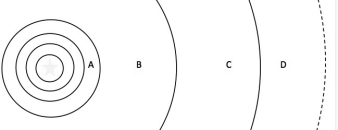
A) A
B) B
C) C
D) D

A) A
B) B
C) C
D) D

فتح الحزمة
افتح القفل للوصول البطاقات البالغ عددها 70 في هذه المجموعة.
فتح الحزمة
k this deck
48
Explain the differences between meteoroids,meteorites,and meteors.

فتح الحزمة
افتح القفل للوصول البطاقات البالغ عددها 70 في هذه المجموعة.
فتح الحزمة
k this deck
49
The figure below shows the orbits of planets within our Solar System (not to scale),with three of the orbits labeled by letters A,B,and C.Which type of planet is most likely to follow each of these orbits?
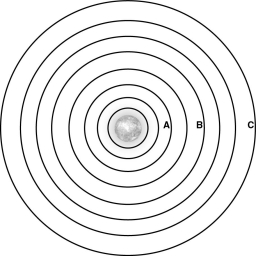


فتح الحزمة
افتح القفل للوصول البطاقات البالغ عددها 70 في هذه المجموعة.
فتح الحزمة
k this deck
50
Compare the following properties between Mars and Jupiter: mass,orbital radius,rotation rate,and density.

فتح الحزمة
افتح القفل للوصول البطاقات البالغ عددها 70 في هذه المجموعة.
فتح الحزمة
k this deck
51
Two comets approach the Sun with the same perihelion distance.Comet A's orbit has a higher eccentricity and is more inclined relative to the ecliptic than comet B's orbit.Which comet is more likely to come from the Oort Cloud?

فتح الحزمة
افتح القفل للوصول البطاقات البالغ عددها 70 في هذه المجموعة.
فتح الحزمة
k this deck
52
An asteroid follows a highly elliptical orbit that carries it into the inner Solar System.What could eventually happen to it?

فتح الحزمة
افتح القفل للوصول البطاقات البالغ عددها 70 في هذه المجموعة.
فتح الحزمة
k this deck
53
Suppose that a protoplanetary disk around a Sun-like star is heated past about 5 AU by an unknown process.How might the resulting planetary system differ from our own?
A) The outer planets would orbit faster.
B) The outer planets would be rockier.
C) The outer planets would be more massive.
D) This would not affect any of the planets.
A) The outer planets would orbit faster.
B) The outer planets would be rockier.
C) The outer planets would be more massive.
D) This would not affect any of the planets.

فتح الحزمة
افتح القفل للوصول البطاقات البالغ عددها 70 في هذه المجموعة.
فتح الحزمة
k this deck
54
The figure below shows the orbits of the planets within the Solar System as well as the orbits of three other objects labeled A,B,and C.Based on their orbits,of what parts of the Solar System are objects A,B,and C part?
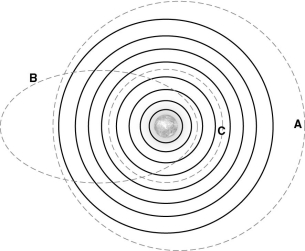


فتح الحزمة
افتح القفل للوصول البطاقات البالغ عددها 70 في هذه المجموعة.
فتح الحزمة
k this deck
55
The figure below shows the orbit of a comet around the Sun.Sketch the locations of the comet's ion and dust tails at points A,B,and C.
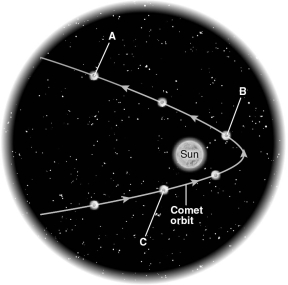


فتح الحزمة
افتح القفل للوصول البطاقات البالغ عددها 70 في هذه المجموعة.
فتح الحزمة
k this deck
56
Which of the following would most directly favor the core accretion model over the hydrodynamic instability model for the formation of giant planets?
A) an accurate census of the "hot Jupiters"
B) observations of comet-gas giant collisions in our Solar System
C) a detection of a massive, rocky core in the outer part of a very young protoplanetary disk
D) precise calculations of the formation sites of Jupiter and Saturn
A) an accurate census of the "hot Jupiters"
B) observations of comet-gas giant collisions in our Solar System
C) a detection of a massive, rocky core in the outer part of a very young protoplanetary disk
D) precise calculations of the formation sites of Jupiter and Saturn

فتح الحزمة
افتح القفل للوصول البطاقات البالغ عددها 70 في هذه المجموعة.
فتح الحزمة
k this deck
57
What property of the protoplanetary disk was most responsible for differentiation between the planets?
A) temperature
B) composition
C) density
D) illumination
A) temperature
B) composition
C) density
D) illumination

فتح الحزمة
افتح القفل للوصول البطاقات البالغ عددها 70 في هذه المجموعة.
فتح الحزمة
k this deck
58
Binary accretion describes the:
A) buildup of planetesimals through collisions.
B) gravitational capture of gas by a black hole.
C) rapid growth of giant planets through gas instabilities.
D) merger of two stars in a close mutual orbit.
A) buildup of planetesimals through collisions.
B) gravitational capture of gas by a black hole.
C) rapid growth of giant planets through gas instabilities.
D) merger of two stars in a close mutual orbit.

فتح الحزمة
افتح القفل للوصول البطاقات البالغ عددها 70 في هذه المجموعة.
فتح الحزمة
k this deck
59
What is a dwarf planet?

فتح الحزمة
افتح القفل للوصول البطاقات البالغ عددها 70 في هذه المجموعة.
فتح الحزمة
k this deck
60
The orbits of gas giants can move after their formation because of:
A) cooling of the planet.
B) transfer of angular momentum from the planet's rotation to its orbit.
C) evolution of the central protostar.
D) collisions with comets.
A) cooling of the planet.
B) transfer of angular momentum from the planet's rotation to its orbit.
C) evolution of the central protostar.
D) collisions with comets.

فتح الحزمة
افتح القفل للوصول البطاقات البالغ عددها 70 في هذه المجموعة.
فتح الحزمة
k this deck
61
Why do the compositions of planets in our Solar System depend on distance from the Sun?

فتح الحزمة
افتح القفل للوصول البطاقات البالغ عددها 70 في هذه المجموعة.
فتح الحزمة
k this deck
62
Suppose Jupiter's orbit suddenly became highly eccentric.How would this affect the Solar System?

فتح الحزمة
افتح القفل للوصول البطاقات البالغ عددها 70 في هذه المجموعة.
فتح الحزمة
k this deck
63
How did the first exoplanets to be discovered differ from those in our Solar System?

فتح الحزمة
افتح القفل للوصول البطاقات البالغ عددها 70 في هذه المجموعة.
فتح الحزمة
k this deck
64
What is the key difference between the core accretion and hydrodynamic instability models for gas giant formation?

فتح الحزمة
افتح القفل للوصول البطاقات البالغ عددها 70 في هذه المجموعة.
فتح الحزمة
k this deck
65
Why are planetary systems disks with rapid rotation if they begin their lives as spherical,slowly rotating gas clouds?

فتح الحزمة
افتح القفل للوصول البطاقات البالغ عددها 70 في هذه المجموعة.
فتح الحزمة
k this deck
66
How would the outer parts of our Solar System be different if the gaseous portion of the protoplanetary disk remained for longer?

فتح الحزمة
افتح القفل للوصول البطاقات البالغ عددها 70 في هذه المجموعة.
فتح الحزمة
k this deck
67
The figure below shows the orbits of three gas giants around the star Upsilon Andromedae (labeled B,C,and D in the diagram,following their astronomical names).How do the orbits of these planets differ from gas giants in our Solar System?
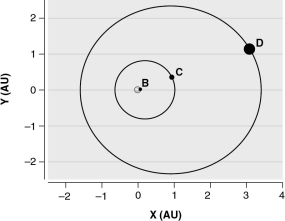


فتح الحزمة
افتح القفل للوصول البطاقات البالغ عددها 70 في هذه المجموعة.
فتح الحزمة
k this deck
68
How do terrestrial planets form?

فتح الحزمة
افتح القفل للوصول البطاقات البالغ عددها 70 في هذه المجموعة.
فتح الحزمة
k this deck
69
A star-exoplanet system is oriented on the sky as shown in the figure below,which shows several snapshots of the planet's orbit.How could astronomers measure the density of this planet?



فتح الحزمة
افتح القفل للوصول البطاقات البالغ عددها 70 في هذه المجموعة.
فتح الحزمة
k this deck
70
Astronomers discover a star with several planets orbiting it.The planets have orbits with a wide range of inclinations,and (as viewed from Earth)half orbit clockwise,while half orbit counterclockwise.How must the formation of this system have differed from the formation of our own Solar System?

فتح الحزمة
افتح القفل للوصول البطاقات البالغ عددها 70 في هذه المجموعة.
فتح الحزمة
k this deck








